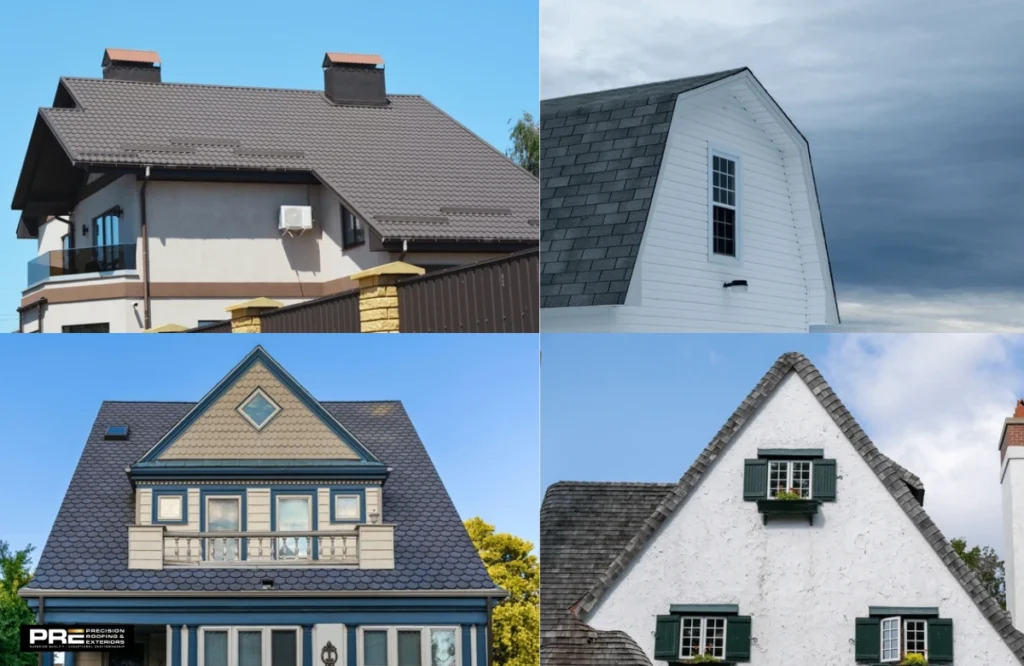The roof is one of the most important parts of any building, affecting a home’s style and durability. Among various roofing designs, the gable roof is one of the most popular choices due to its simplicity, strong drainage, and classic look.
Gable roofs have two sloping sides that meet at a ridge, forming a triangular shape at each end. Common gable roof types include box, cross, Dutch, front, and open gables. Other variations, such as the gambrel and saltbox roofs, also provide a unique style and functionality.
Different Types of Gable Roofs
Here are the common types:
1. Box Gable Roof
A box gable roof is a traditional design with triangular ends fully enclosed with siding. This roof creates a clean and finished look while protecting against wind and rain. It is commonly used in residential homes where a neat, symmetrical appearance is desired. The enclosed ends also make it easier to insulate the attic and protect it from pests.
Benefits:
- Offers excellent weather protection for the triangular ends.
- Simple and cost-effective to build.
- Provides extra attic or storage space inside.
2. Cross Gable Roof
A cross-gable roof occurs when two gable roofs intersect at right angles. This design is often used for homes with multiple sections or wings, creating an “L” or “T”-shaped layout. It allows for more complex floor plans and can help create separate zones within the house. The intersecting sections also provide additional interior ceiling height for a spacious feel.
Benefits:
- Enhances visual appeal with a more complex, interesting roofline.
- Allows for different ceiling heights in separate sections of the home.
- Improves water drainage due to multiple slopes.
3. Dutch Gable Roof
The Dutch gable roof combines a gable and a hip roof. A small hip sits at the top of the gable, giving it a distinctive look and improved stability against strong winds. This design is ideal for homeowners who want the aesthetic appeal of a gable roof but the structural advantages of a hip roof. It also allows for more windows or ventilation in the upper portion of the home.
Benefits:
- Provides more attic space while retaining wind resistance.
- Adds a stylish, elegant appearance to the home.
- Works well in areas prone to storms and high winds.
4. Front Gable Roof
The front gable roof has the gable facing the front of the house, making it a popular choice for classic residential homes. This design often emphasizes the entrance and creates a symmetrical facade. It can give smaller homes a taller, more impressive look from the street. Front gables are also great for adding decorative elements like windows, vents, or architectural trim.
Benefits:
- Enhances curb appeal by highlighting the front of the home.
- Allows for vaulted ceilings inside.
- Simple construction reduces costs.
5. Open Gable Roof
Open gable roofs expose the triangular ends, rather than enclosing them with siding. This can create a more airy and modern appearance. The open ends allow for improved attic ventilation, reducing heat buildup in warmer months. They also make installing decorative beams or trusses easier for a stylish interior ceiling.
Benefits:
- Allows for more natural ventilation in the attic.
- Creates a modern, open appearance.
- Easier and faster to construct than fully boxed designs.
6. Gambrel Roof
The gambrel roof is often seen in barns and farmhouses. It has two slopes on each side: a steep lower slope and a shallower upper slope, creating more usable space in the upper level. This design is excellent for creating large lofts or extra storage areas without building a full second story. Gambrel roofs also give homes a traditional, rustic charm.
Benefits:
- Maximizes attic or loft space.
- Offers a unique, traditional style.
- Handles rain and snow efficiently with its steep lower slope.
7. Saltbox Roof
A saltbox roof is an asymmetrical design where one side is longer than the other. This style is popular in colonial-style homes and provides additional living space in the back. The long rear slope helps protect back porches or extensions from rain and wind. Saltbox roofs are also energy-efficient because the slope allows natural airflow over the building.
Benefits:
- It adds more room at the rear of the house without raising the overall height.
- Distinctive look that suits traditional architecture.
- Good at shedding rain and snow due to the long slope.
Conclusion
Gable roofs are versatile, practical, and visually appealing, making them a top choice for many homeowners. From the traditional box gable to the more complex gambrel and Dutch gable designs, each type offers unique benefits like added attic space, better ventilation, and improved water drainage. Knowing the different types of gable roofs helps you choose the best design for your home’s style, climate, and functionality.
Contact professional roofing company like Precision Roofing for expert roof installation and advice on the best gable roof for your home to ensure quality, durability, and long-lasting protection.

